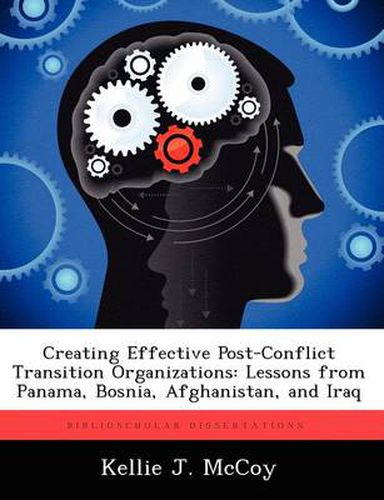Readings Newsletter
Become a Readings Member to make your shopping experience even easier.
Sign in or sign up for free!
You’re not far away from qualifying for FREE standard shipping within Australia
You’ve qualified for FREE standard shipping within Australia
The cart is loading…






This title is printed to order. This book may have been self-published. If so, we cannot guarantee the quality of the content. In the main most books will have gone through the editing process however some may not. We therefore suggest that you be aware of this before ordering this book. If in doubt check either the author or publisher’s details as we are unable to accept any returns unless they are faulty. Please contact us if you have any questions.
The contemporary operational environment includes a host of variables that make the management of post-conflict transitions a challenge. Constructing the optimal management organization is a key component of successful post-conflict transition. This thesis examined four organizations: the Military Support Group-Panama which was established following the U.S. invasion of Panama in 1989, the Office of the High Representative which was at the center of the peace operation in Bosnia from 1995 to the present, the post-conflict transition in Afghanistan following the U.S.-led invasion in 2001, and the Coalition Provisional Authority in Iraq. The Military Support Group-Panama illustrated the strengths and weaknesses of a purely military organization and how it worked in the unique situation of Panama. However, the Bosnia situation called for broader international involvement and the Office of the High Representative served as the focal point for a complex organization. The ongoing conflicts in Afghanistan and Iraq offered a comparison of vastly different organizations operating in the contemporary operating environment. The four case studies showed that post-conflict transition and reconstruction and stabilization operations can benefit from a tailored management organization that emphasizes simplicity, responsiveness, flexibility, sustainability, and efficiency to achieve maximum success.
$9.00 standard shipping within Australia
FREE standard shipping within Australia for orders over $100.00
Express & International shipping calculated at checkout
This title is printed to order. This book may have been self-published. If so, we cannot guarantee the quality of the content. In the main most books will have gone through the editing process however some may not. We therefore suggest that you be aware of this before ordering this book. If in doubt check either the author or publisher’s details as we are unable to accept any returns unless they are faulty. Please contact us if you have any questions.
The contemporary operational environment includes a host of variables that make the management of post-conflict transitions a challenge. Constructing the optimal management organization is a key component of successful post-conflict transition. This thesis examined four organizations: the Military Support Group-Panama which was established following the U.S. invasion of Panama in 1989, the Office of the High Representative which was at the center of the peace operation in Bosnia from 1995 to the present, the post-conflict transition in Afghanistan following the U.S.-led invasion in 2001, and the Coalition Provisional Authority in Iraq. The Military Support Group-Panama illustrated the strengths and weaknesses of a purely military organization and how it worked in the unique situation of Panama. However, the Bosnia situation called for broader international involvement and the Office of the High Representative served as the focal point for a complex organization. The ongoing conflicts in Afghanistan and Iraq offered a comparison of vastly different organizations operating in the contemporary operating environment. The four case studies showed that post-conflict transition and reconstruction and stabilization operations can benefit from a tailored management organization that emphasizes simplicity, responsiveness, flexibility, sustainability, and efficiency to achieve maximum success.